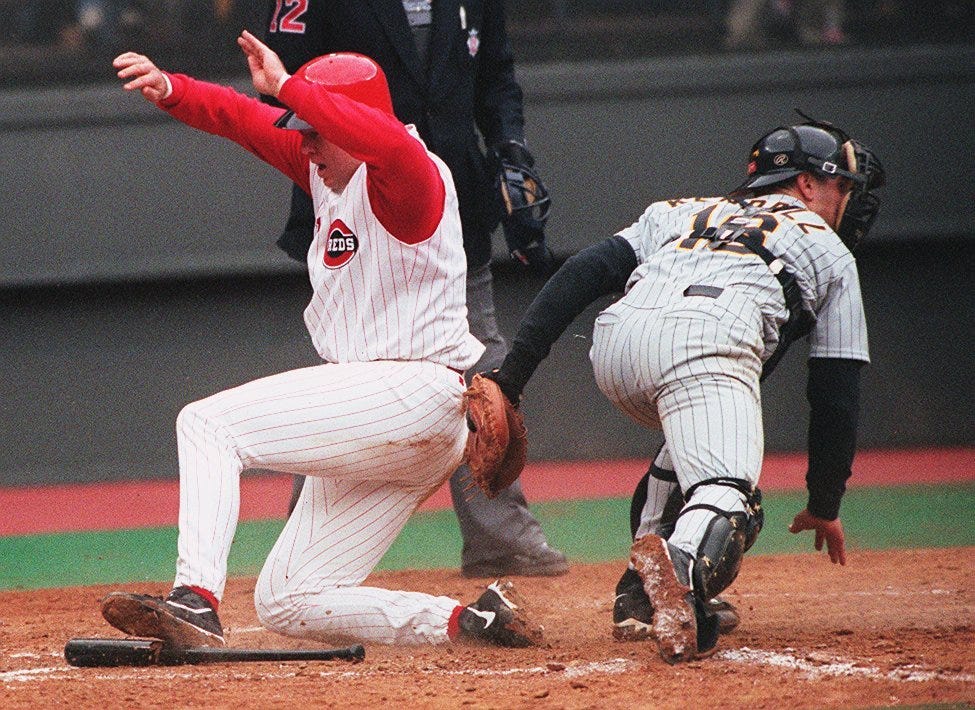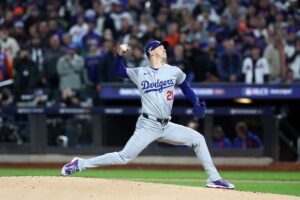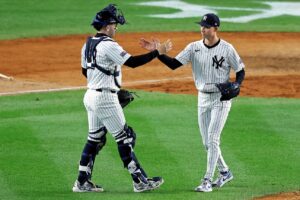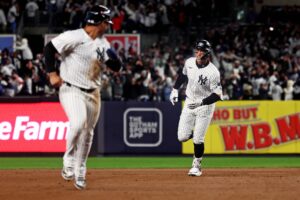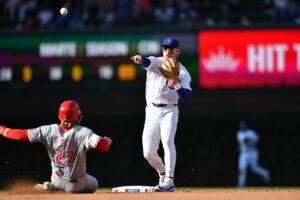The Pittsburgh Pirates aren’t known for handing out large multiyear contracts, but they’re starting to reverse that trend. With the recent extension of Mitch Keller, the Pirates have now given lucrative extensions to a key player three years in a row.
The Pirates once had the highest-paid player in the game in Dave Parker, who was given a five-year, $5 million contract in 1979 after winning two consecutive batting titles and a Most Valuable Player Award. At that time, the local steel industry was undergoing a severe downturn. Pittsburgh fans couldn’t relate to a ballplayer making a seven-figure salary. It didn’t help that Parker was a bold, flamboyant Black man who spoke in rhyme like a baseball version of Muhammad Ali. He had objects thrown at him. The fans booed him out of town, on to the Reds and his native Cincinnati when his deal was up. Pirates fans who remember those times don’t recognize today’s fan base, urging the owner to spend money on multimillion-dollar ballplayers and how things have changed.
But let’s leave Parker for a moment. Look at how big contracts have worked for the Pirates, beginning with the largest in total dollars.
The Quiet Man
Bryan Reynolds, eight-year, $106.75 million extension, 2023. Reynolds came to the Pirates from the San Francisco Giants in the 2018 Andrew McCutchen trade. Since joining the major league club in 2019, he’s arguably been their best and most consistent player. In five seasons, he’s hit .277/.354/.476, 98 HR, and 323 RBI. His best season was in 2021 when he hit .302/.390/.522, 24 HR, and 90 RBI and was selected for the All-Star Game. After playing primarily in center field in 2021 and 2022, he returned to left field, which suits him better.
Initially, negotiations for his extension became contentious. Much to the chagrin of both parties, word leaked that he had asked for a trade. Owner Bob Nutting stepped in, communicated to Reynolds that he was valued, and got the deal done. Of course, anybody who’s seen Reynolds play wasn’t worried about him being unhappy. He likes Pittsburgh, doesn’t make waves, plays hard, and plays to win.
The Staff Ace
Mitch Keller, five-year, $77 million extension, 2024. This deal yields the highest average salary the Pirates have ever given a player. In 2023, the right-handed starter was an All-Star, producing a 13-9 record with a 4.21 ERA and 1.245 WHIP. The ERA is misleading because of a few occasions in the second half where he remained in the game and took some lumps to save the bullpen. He struggled early in his career before going to the bullpen and discovering a sinker in the second half of 2022. He’s being paid for what he’ll do in the future. When the extension was announced, Keller spoke of appreciating how the Pirates stuck with him through the tough times. Pirates fans should be excited about a future one-two punch of Keller and top prospect Paul Skenes in the rotation.
Sunflower Seeds and Earbuds
Ke’Bryan Hayes, eight-year, $70 million extension, 2022. The 2015 No. 1 draft choice and son of former major leaguer Charlie Hayes can be hard to figure. He gives the Bucs elite defense at third base. He won a Gold Glove Award last year and probably should have won one the year before. On the other hand, he’s been inconsistent with the bat and at the center of some embarrassing incidents. Over four seasons, he’s hit .264/.320/.409, 33 HR, and 151 RBI. In 2021, he hit a ball over the fence and was called out for missing first base as he rounded the bases. In 2022, TV cameras caught him reaching into his back pocket for sunflower seeds when he should have covered the bag. Facing the media with an earbud in his ear, he expressed no remorse. It was a bad look.
In any event, last year, he sought the help of a double-A coach to work on his hitting. The work paid off. He finished strong, raising his average from .248 on August 2 to .271 at the end of the season. Whatever served as the wake-up call, it looks like the real Ke’Bryan Hayes is the guy who put in the extra work to become a better hitter, not the seed-eating spectator justifying the contract the Pirates gave him.
The Kid
Jason Kendall, a six-year contract for $60 million, was in 2000. Known as “The Kid,” Kendall was in the right place at the time. In lobbying the city for PNC Park to be built, then-owner Kevin McClatchy said it would help the Pirates keep their key players from leaving for more money. After that statement, Kendall was the first player to have an expired contract. As a result, the Pirates ridiculously overpaid for a singles-hitting catcher who was average defensively and unwilling to go out into the community. Worse yet, Kendall was part of a group of veterans who hazed young shortstop Jack Wilson. On the plus side, his offense was nothing to complain about. In nine years with Pittsburgh, Kendall hit .306/.387/.418, 67 HR, and 471 RBI. Even so, the Pirates would ship him to Oakland after the 2004 season.
Cutch
Andrew McCutchen, six-year, $51.5 million extension, 2012. This deal was the definition of a “hometown discount.” All “Cutch” ever did for the Pirates was win the 2013 Most Valuable Player Award, a Gold Glove Award, and four Silver Slugger Awards while being named an All-Star for five consecutive years. As a Pirate from 2009-17 and 2023, he’s hit .288/.379/.481, 215 HR, and 768 RBI with 182 stolen bases. McCutchen was the face of the franchise during its three-year run of success from 2013-15, during which they were one of the NL wild cards. Indeed, he deserved a bigger deal than Kendall. He showed how he feels about Pittsburgh and the Pirates by returning in 2023 for a lesser contract than he likely would have received by testing the market. Someday, his number 22 will be among the retired numbers displayed at PNC Park.
Big Numbers
Brian Giles, six-year, $45 million extension, 2000. The Pirates were so bad during Giles’s time that it’s easy to forget he put up some eye-popping numbers in Pittsburgh. From 1999 until he was traded to the San San Diego Padres during the 2003 season, he hit .308/.426/.591, 165 HR, and 506 RBI while playing great defense in the outfield. Sadly, he was also part of the group above of divisive veterans. The Pirates picked the right time to trade him. Giles played with the Padres through 2009 and was never as good as he was with the Pirates.
Francisco Liriano, three-year, $39 million contract, 2014. Speaking of big numbers, this is the largest contract the Pirates have ever given to a free agent. This after a 2013 season when Liriano was 16-8 with a 3.02 ERA and 1.224 WHIP for the Pirates and pitched a strong game in winning the Wild Card Playoff Game. However, his career had always been up and down, and in 2016 he regressed. That year for the Bucs, he was 6-11 to go with some ugly figures: a 5.46 ERA, 1.619 WHIP, and 5.28 FIP. He was traded to the Toronto Blue Jays for Drew Hutchison at the deadline. The Pirates threw in two top prospects to entice Toronto to take on the rest of Liriano’s salary. Hutchison was mere window dressing. He was never given a chance to crack the Pirates’ pitching staff.
Losing a Big Bet
Gregory Polanco, five-year, $35 million extension, 2016. The Pirates made a big bet on Polanco. In 2018, they had four outfielders in: Corey Dickerson, Starling Marte, Austin Meadows, and Polanco. Dickerson hit .300/.330/.474 while winning a Gold Glove Award. Meadows was a former No. 1 draft choice. Marte and McCutchen were going nowhere. The Pirates dealt Meadows to the Tampa Bay Rays in the now-infamous 2018 Chris Archer trade, making room for Dickerson. Reynolds was called up in 2019, again creating a crowded four-man outfield. Dickerson, hitting .315 then, was traded for international bonus pool money.
Meanwhile, the Pirates picked the wrong guy twice. In eight years as a Pirate, Polanco hit .241/.309/.409, 96 HR, and 362 RBI while striking out 694 times. He regressed as a hitter, his defense was below average, a shoulder injury weakened his throwing arm, and his slides were awkward. Finally, despite the big contract, the Pirates had seen enough and released him in 2021.
Two $31 Million Deals
Francisco Cervelli, three-year, $31 million extension, 2016. The popular, fist-pumping catcher’s arrival in 2015 quickly alleviated Pirates fans’ anger over losing Russell Martin to free agency. In five years as a Pirate, Cervelli hit .264/.362/.374 while serving as a fiery team leader. Unfortunately, he suffered multiple concussions behind the dish. There were one too many concussions in 2019. The Pirates couldn’t, in good conscience, continue his career and release him. Subsequent attempts to press on with two other teams didn’t work out.
Starling Marte, six-year, $31 million extension, 2014. By now, the reader has detected a pattern. Rightly or wrongly, under Nutting, the Pirates have preferred to give a large contract to players who have served them well instead of free agents from other teams. In eight years as a Pirate, the graceful five-tool outfielder hit .287/.341/.452, 108 HR, and 420 RBI while stealing 239 bases. There was also the occasional mental lapse. The Pirates had to take the good with the bad, and fortunately, the good far outweighed the bad, although there was also his disappointing suspension for using PEDs in 2017. Marte was reportedly unhappy in Pittsburgh in 2019. Thus, he was the first player traded when Ben Cherington took over after that season.
The Last Word
So, we’ve discussed 10 big contracts. With the benefit of hindsight, perhaps the only mistakes were those given to Kendall and Polanco. Getting back to Parker, as it turned out, his $5 million Pirates contract consisted of $5.3 million in deferred money due to interest. In 1985, Parker testified in the infamous “baseball cocaine trials” that he stopped using cocaine because it was negatively affecting his performance on the field. Oops! An admission under oath in court is considered strong evidence that the admission is valid. In 1986, a consortium of publicly held corporations purchased the Pirates. The consortium jumped on Parker’s statement and sued him for breach of contract to get out from under the deferred obligation. The matter was settled out of court, with Parker getting less than what was due to him. The first $1 million-per-year ballplayer wasn’t that after all.
Main Photo Credits: Ernest Coleman


